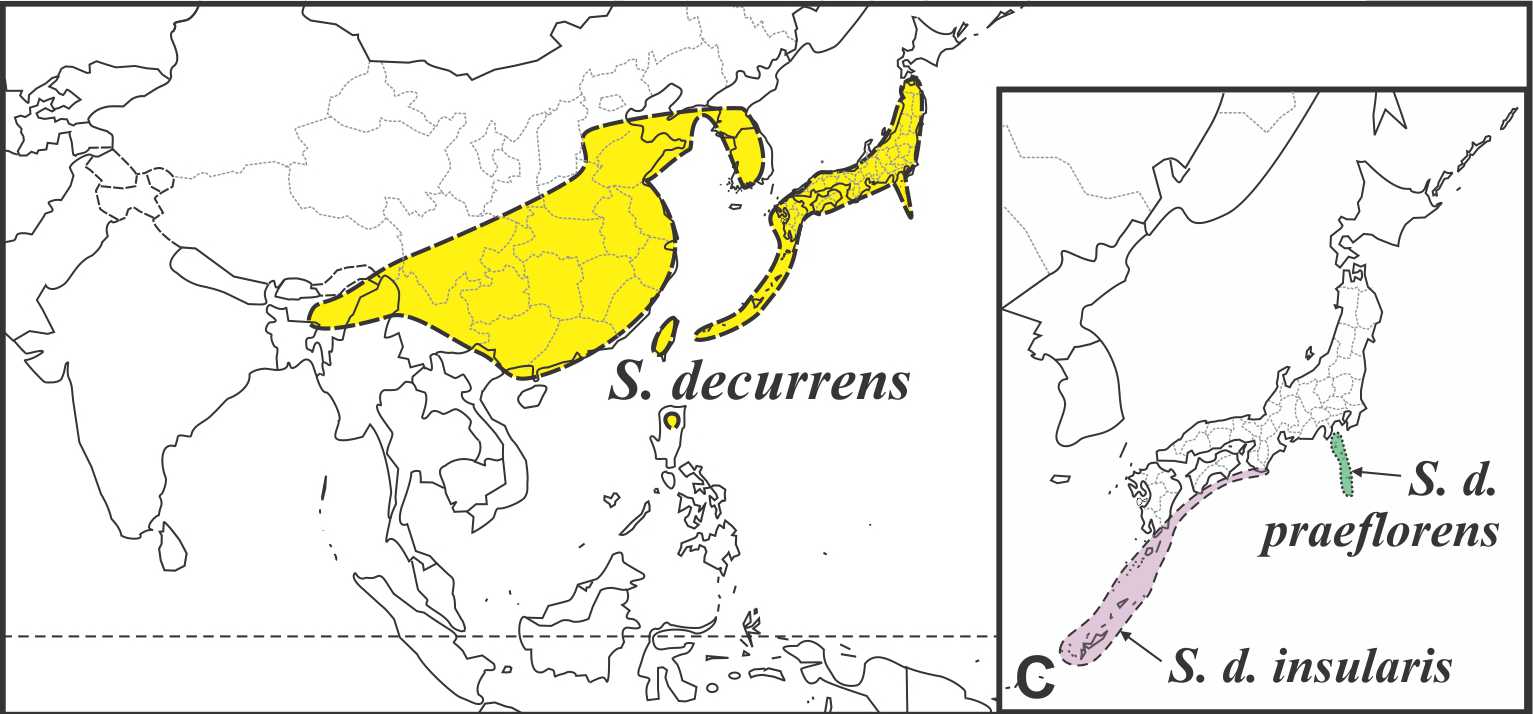Solidago decurrens Loureiro (1790) is the common species of goldenrod native to eastern and southern China, South Korea, Taiwan and much of Japan. Its range also includes a bit of northern Vietnam and the northern Philippines. The range overlaps with four other native species in eastern Asia. It has smaller heads than S. dahurica; its leaf bases taper rather than being truncate as in S. kurilensis (synonym S. nipponica); it is usually much taller than S. minutissima, and its lower leaves are much larger than the upper leaves unlike the rheophyte S. yokusaiana whose serrate upper leaves are less reduced and its fruit bodies are moderately hairy. The fruit body of S. decurrens is normally hairless like the fruit body of the rare rheophyte of Okinawa Is. S. yambaruensis. It is also likely related to the rare rheophyte S. horieana of Hokkaido, Japan.

It was treated as a distinct species in the English version of the Flora of China (Chen & Semple 2011).
The species was divided into three varieties based in part on results of a multivariate study of S. ser. Solidago by Semple et al. (2020): var. decurrens, var. insularis (Kitamura) Semple, and var. praeflorens ((Nakai) Kitamura. Var. decurrens occurs over nearly all the range of the species, blooms in the summer and fall, ranges from (14-)21-131 cm in height with the tallest plants often loosing lower stem leaves by the flowering time. Var. insularis occurs along the Ryukyo Arch, blooms from January to May, and above ground portions of the stem persist with leaves clustered on lower portions of more recent growth. Var. praeflorens occurs on the Izu archipelago, stems are short, and cypselae are strigose distally. Further stu of var. insularis and var. praeflorens is needed. Sakaguchi et al. (2018) found some molecular differentiation among the varieties, although they did not follow the nomenclature presented here.
Synonyms: Solidago cantoniensis Loureiro neotype same as holotype of A. leiocarpa (Semple et al. 2020); Amphirhapis leiocarpa Benth. in Hook.f., Lond. J. Bot. 1: 488. 1842; S. virgaurea L. ssp. leiocarpa (Bentham) Hultén, Fl. Aleut. 315. 1937; Solidago virga-aurea L. var. glabriuscula Clarke, Comp. Ind. 35. 1876; S. virgaurea var. leiocarpa (Bentham) A. Gray, Mem. Amer. Acad. n.s. 6(2): 395. 1859. non Miq. (1861); S. japonica Kitm., Acta Phytotax. Geobot.1932; Solidago virgaurea ssp. asiatica Kitamura, Mem. Coll. Sci. Kyoto Univ. Ser. B. 13: 398. 1937. nom. nud.; S. virgaurea var. paludosa Honda, Bot. Mag. Tokyo 40: 95. 1937; S. virgaurea ssp. asiatica
The species is diploid like all other members of the S. virgaurea complex in the broad sense. Yuzu Sakata is thanked for the digital image of the Japanese plant.
Last revised 17 May 2025 by J.C. Semple
© 2025 J.C. Semple, including all photographs unless otherwise indicated
1-6. Solidago decurrens. 1. Habit, Nagano, Japan image by Yuzu Sakata. 2. Small shoot, Liu s.n. MO, China. 3. Heads, An 3963 MO, Guizhou China. 4. var. praeflorens image by Satoshi Toyoshima. 5. Fruits, Seto 31829 A, Japan. 6. var. insularis, Takamine 2239 US, Japan.
Semple, J.C. 2013. On the name Solidago mirabilis (Asteraceae: Astereae) and a new name for a Japanese species of goldenrod. Phytoneuron 2013-24: 1-9.
Yilin Chen & John C. Semple. 2011. Solidago Linnaeus. pp. 632-634. In Wu, Z. Y., Raven, P. H. & Hong, D. Y., eds., Flora of China Volume 20–21 (Asteraceae). Science Press (Beijing) & Missouri Botanical Garden Press (St. Louis)
Sakaguchi, S., T. Kimura, R. Kyan, M. Maki, T. Nishino, N. Ishikawa, A.J. Nagano, M.N. Honjo, M. Yasugi, H. Kudoh, P. Li, H. Jae Choi, O.A. Chernyagina and M. Ito. 2018. Phylogeographic analysis of the East Asian goldenrod (Solidago virgaurea complex, Asteraceae) reveals hidden ecological diversification with recurrent formation of ecotypes. Ann. Bot. 121: 489–500.
Semple, J.C., Y. Ma, L. Tong, and M. Sorour. 2020. A multivariate morphometric analysis of Solidago sect. Solidago and S. sect. Multiradiatae (Asteraceae: Astereae). Phytoneuron 2020-38: 1–59.











